Pros
Cons
Tour & Design
The front of the Sharp Aquos LC-46D64U is dominated by the 46 inch matte display. Surrounding the display is a glossy black bezel with the Aquos logo at the top left and the Sharp logo centered below the display. You will also find several LED indicators and the sensor for the remote at the bottom right. Below the glossy bezel are the speakers with a silver finish.
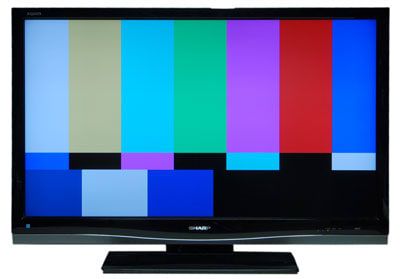
We're not fond of the silver speakers underneath the Sharp Aquos LC-46D64U's bezel.
The back of the Sharp Aquos LC-46D64U is fairly plain with ports arranged in three different grouping. One is found near the bottom middle while the other two are found towards the left side, when facing it from the back, in two groupings.
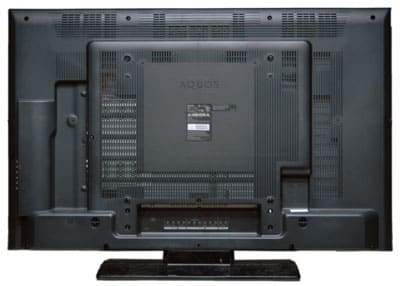
The back is pretty plain jane, but there certainly are a lot of ports there.
There is nothing of note on the left side of the TV.
On the right side of the Sharp Aquos LC-46D64U you will see one of the set of ports along with the on-TV controls.
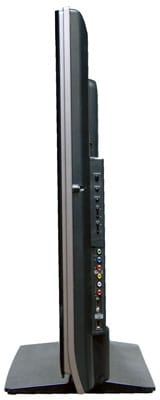
There are another bunch of ports on the right side.
The Sharp Aquos LC-46D64U comes without the stand attached, so you will need to screw it into place. If you want to mount the TV on your wall you will need to remove the stand and purchase a separate wall mounting accessory.
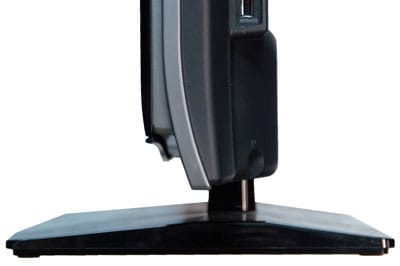
The stand is sturdy.
The controls of the Sharp Aquos LC-46D64U are found on the right side of the TV. They are arranged above one of the sets of ports and from top to bottom are Power, Menu, Input, Ch+, Ch-, Vol+, Vol-. These controls can also be used to navigate the menu if necessary.

The on-TV controls are pretty typical fare.
The TV ships with a remote and two AAA batteries are included. The remote is rather long and angular with a strange hinged compartment near the bottom that reveals some additional controls.
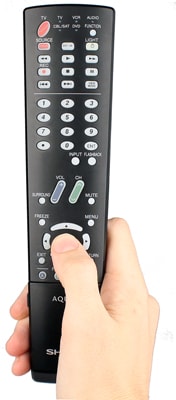
The remote not only looks ugly, it doesn't work very well either.
In addition to the remote and batteries the Sharp Aquos LC-46D64U ships with a power cord, manual and all the various screws you will need to connect the stand to the TV. It does not include any cables, which is a shame. We feel any modern HDTV should ship with at least on HDMI cable to get you started. The TV was relatively easy to get out of the box, as easy as any other TV, without any complicated packaging. Simply open the top, remove the spacers and pull the TV out.
The Sharp Aquos LC-46D64U sports a relatively simple design. The most different feature from other modern TVs is the silver speakers beneath the bezel. In our mind this does not add to the TVs aesthetics, we feel it makes it look a bit cheap, especially compared to a TV like the Samsung LN46A650, which has a uniform glossy black finish.
Performance: Summary
To get the best out of a display, it has to be calibrated, a process that finds the correct settings for the individual display. We use the DisplayMate calibration process to set the display up correctly; the calibrated settings that we found to give the best overall performance are listed below.
That's only a few minor changes to get the screen calibrated.

The LC-46D64U is a full HD screen, which means that it has enough pixels to accurately represent every pixel of a 1080p signal. The image on the right (taken with a 20x microscope) shows the dot pattern of the LC46-D64U, which has a slightly unusual arrangement. Every pixel is composed of two red elements, two green ones and a single blue one. All of the elements in the display seem to be the same size, but there are twice as many red and green elements as there are blue. This is unusual; most of the panels on displays we've seen have groups of three elements forming the pixels.
Performance: Blacks & Whites

](https://www.reviewed.com/televisions/content/How-We-Test.htm#blacklevel)
As a general rule, the deeper the black level of the TV, the better images will look. Deep, dark blacks make for more dramatic scenes and more realism. The Sharp was in the middle of the pack for black level, though; we measured it at 0.19 cd/m2 (candelas per meter squared, a standard measurement of luminance). That's pretty decent for an LCD HDTV; the JVC LT-47x899 hd much lighter blacks at 0.37 cd/m2, but the Sony Bravia 46w4100 was significantly better at 0.09 cd/m2.

](https://www.reviewed.com/televisions/content/How-We-Test.htm#peakwhite)
The other side of the coin is peak brightness; the brightest white that the TV can manage. The Sharp had no shortage here; we measured it at an eye-watering 395.42 cd/m2. That's one of the brightest that we've seen; only the Samsung LN46A750 was brighter at 426.3 cd/m2. Of course, peak brightness is only part of the equation, but it is definitely nice to have the brightness there if it is needed for watching the TV in daylight.

](https://www.reviewed.com/televisions/content/How-We-Test.htm#contrastratio)
Contrast ratio is the balance between the light and the dark, and a TV with a good contrast ratio will look better overall. The Sharp LC46-D64U did well here; we measured the contrast ratio at 2842:1. Again, that's a strong score that is significantly higher than many other TVs; the Vizio VO47LF, for instance, managed just 713:1.

](https://www.reviewed.com/televisions/content/How-We-Test.htm#tunnelcontrast)
Whites and blacks seldom exist in isolation on the screen, which is why we test the tunnel contrast, where we look at how the blacks hold up when they are surrounded by white. We do this by measuring a small area of black in the middle of the screen and slowly increasing the amount of white around it. On some TVs the white bleeds into the black, but that didn't seem to be an issue on the LC-46D64U; we only saw a very slight increase in the black, even when the rest of the screen was white.

](https://www.reviewed.com/televisions/content/How-We-Test.htm#whitefalloff)
Some displays also have a problem with white; as the amount of white on the screen goes up, the display has to turn down the brightness to keep from overheating. This didn't seem to be an issue for the LC46-D64U; we did not see much variation in our tests with screens with different amounts of white.

](https://www.reviewed.com/televisions/content/How-We-Test.htm#uniformity)
Another important aspect of black and white performance is uniformity; an ideal screen wuld have exactly the same brightness all over the screen for both black and white screens. The LC-46D64U had a few problems here; we noticed that the corners on the white screen were less bright than the center of the screen, and that there were several vertical spots on the dark screen that were lighter as well.

](https://www.reviewed.com/televisions/content/How-We-Test.htm#greyscalegamma)
Update: We have rescaled our scoring for this section. The original score was 1.0.
The LC46-D64U had some rather odd behavior here. When we plot our tests on how a display changes from from black to white as the intensity of the signal increases, we usually expect there to be a curve rather like a child's slide. Instead, the Sharp had a mostly flat curve, like a ski jump.
Another way to look at this is to plot the data onto a graph with logarithmic axis. On this graph, we would expect to see a nice straight line. Instead, we get an s-shaped curve (the blue line is the trend line we add). What this means in practice is that the grays on the screen are going to start out pale, then quickly get significantly darker, without that many shades of gray in between. This is borne out by our examination of a number of test screens; the mid tones of grey were more compressed than we like to see, with more subtle shades at either end of the range getting lost in the blacks and whites.
From this graph we can also extrapolate the gamma, which we would typically expect to see in the range of 2.4 to 2.5. For the Sharp, it is 3.01. This is a very odd result, and not in a good way.
**Resolution Scaling***(6.43)*[

](https://www.reviewed.com/televisions/content/How-We-Test.htm#resolutionscaling)
The LC-46D64U is a 1080p screen, but it doesn't always get to display 1080p signals. It often has to work with lower resolution signals from devices such as cable boxes and DVD players, so we test how well it deals with taking these lower resolution signals and scaling them up to fit the 1080p screen.
480p (5.85)
480p signals are produced by many standard definition devices that have digital outputs, such as standard definition cable boxes, DVD players and some game consoled. The LC-46D64U didn't do a great job with these; we found that text looked a little soft, and that lined and edges were a little jaggier than some displays. The screens were overscanned by about 4 per cent; a fairly standard amount for this type of signal.
720p (6.85)
720p high definition signals (which are often used on sports broadcasts), as the progressive look (where each screen is transmitted in full, 29.97 times a second) looked a little better than their 480p cousins; the text in our test screens was sharper and edges were better defined. But the screens were overscanned again (by about 3 per cent), which is unnecessary with 720p and higher resolution signals. This is easy to deal with (press the view mode button on the remote and select the dot by dot mode), but it is annoying that the display defaults to an overscan mode.
1080i (7.35)
1080i video is the most common form of high definition video; it's what most over the air high definition TV signals are sent in, and it's what most high definition cable boxes output. The LC-46D64U did a decent job here; the images were sharp and we didn't see any major glitches from the deinterlacing that the display has to do to show the signal. But again, the image was overscanned by default for no good reason. And this is especially annoying as 1080i is a mode that's commonly used with a computer, but if the image is overscanned, you loose the menus on the edge of the screen. Again it's relatively easy to switch back to the dot by dot mode, but it is annoying that you have to do this.
Performance: Color
**Color Temperature***(9.88)*[

](https://www.reviewed.com/televisions/content/How-We-Test.htm#colortemperature)
Putting white on the screen of a HDTV isn't as simple as you might think; because the display has to create the white from the three primary colors it can display, there can be problems if the three different colors don't change at the same rate. That's what we test for here, looking for any issues with the whites at different intensity levels having a color cast. The graph below shows the results of our tests: the intensity of the signal (from the brightest white at the left to nearly black on the right) is on the bottom axis, and the color temperature is on the side axis. As part of our calibration process, we set this to as close to 6500k as possible (to simulate daylight), and the line on the graph shows any variation from this.
The variations are very small for most of the way; the graph only shifts slightly from the initial setting. But it goes a bit crazy at the bottom end of the intensity scale, with the whites taking on a distinctly bluish cast. Another way to look at this is to plot the measured color values of the different levels, which is what we do on the next graph. On this graph, the color of the white for the maximum intensity is at the center of the graph, and the dots indicate the color of the whites at different intensity levels. The red circle indicates the color shift that the human eye can detect; if a dot falls within this circle, you aren't going to be able to see the a color change. But if a dot falls outside of the circle, you might be able to spot the color shift.
Again, you can see that quite a few of the dots fall outside the circle, although the majority are nicely within the circle limit. This means that for most intensities of white, the LC-46D64U has good, consistent whites. But with low intensity whites (such as shadow details), the color of the white shifts towards the blue. However, this shift is limited to a small part of the range, and should not be an issue for most users.

](https://www.reviewed.com/televisions/content/How-We-Test.htm#rgbcurves)
All TVs make the colors you see on screen by mixing the primary colors; red, green and blue. They do this by turning on and off the red, green and blue elements of the screen, and your eye does the work of combining the colors to make the required color. To create an area of yellow, for instance, the HDTV turns on the red and green elements. More subtle colors are created by turning on the elements gradually; a more orange-yellow can be created by turning down the intensity of the green. In order to accurately reproduce colors, HDTVs need an accurate response to each of the primary colors; if a slight change in intensity in the incoming signal doesn't translate into a slight change in the luminance of the color on the screen, colors are not going to be accurate. So, we test the response of each of the primary colors, and the results are on the graph below. On these graph, the intensity of the signal is along the bottom, and the resulting luminance is along the side.
These graphs have some issues; they are a little bumpy and have slightly different slopes. The bumps indicate that the response of the HDTV is not smooth; there are points where the response suddenly jumps, and issues like this can cause inaccurate colors and color banding. This is where a subtle change in color (such as a blue sky) becomes a sudden one, and we saw some evidence of this in our tests with sample images on the LC-46D64U; some images had distinct, unattractive color banding.

](https://www.reviewed.com/televisions/content/How-We-Test.htm#colorgamut)
An international group of experts has defined a set of guidelines on the limits for what colors a HDTV signal should contain (called the Rec.709), and a good HDTV should match those limits. So, we test this by looking at what the color gamut of a HDTV is. This is shown on the graph below; the dotted line is the limits set in the recommendation, and the solid line is what we saw from the LC-46U64U.
The blue and red corners of the gamut are pretty close to where they should be, but the green is a little bit off, with the gamut edge being shifted towards the blue. This could cause some colors to look inaccurate; bright greens in particular will look a little bluer than they should. For the hardcore color space fans amongst you, the chromaticity values of the colors are in the table below.
Performance: Motion
**Motion Smoothness***(5.75)*[

](https://www.reviewed.com/televisions/content/How-We-Test.htm#motion)
Smooth movement in video is vital to getting the look and feel of a movie or TV show right; if the movement is either jerky or smeary, it can ruin the image. The Sharp Aquos LC-46D64U veered more towards the smeary side of things; we found that fast-moving objects left a smeary trail behind them in the default mode. Enabling the Fine Motion mode that this display offers helped to some degree; it made motion sharper and better defined. But the motion just did not look as smooth as it did on other models that offer 120Hz refresh rate; there was a definite improvement with the newer models that include it.
**Motion Artifacting***(6.0)*[

](https://www.reviewed.com/televisions/content/How-We-Test.htm#motion)
Many video processing modes make the motion sharper, but mess up the image in other ways, either blurring the image or otherwise messing it up. We didn't see any evidence of that with the Fine Motion mode, though; it did not seem to add any problems to the video, and it definitely made the video look better.
**3:2 Pulldown & 24fps***(5.0)*[

](https://www.reviewed.com/televisions/content/How-We-Test.htm#3:2pulldown)
Some TV shows and all movies are shot at 24 frames per second, then converted to the 29.97 frames per second of video through a process called telecine. Most modern TVs can detect this and try and restore the 24 frames per second look of the image through a process called a 3:2 pulldown. The Sharp did an excellent job of this; with the Film Mode enabled for our test sequence that we use to try this out, we found that the video had a clean, smooth look that definitely captured the feel of film. The LC-46D64U was less successful at displaying a true 24 frames per second video source, though; when we tried this with a Blu-ray disc playing on a PS3, the Sharp was unable to display the image.
Performance: Viewing Effects

](https://www.reviewed.com/televisions/content/How-We-Test.htm#viewingangle)
Not everyone gets to sit right in front of the TV; if you are a younger sibling in a large family, you might end up looking at the TV from quite a large angle. That's why we test the viewing angle of TVs, examining how the display behaves as the observer moves off-axis. The LC-46D64U had middling performance here; we measured the angle at which the contrast ratio dropped by 50 per cent at 21 degrees for a total viewing angle of 42 degrees. That's in the middle of the range that we've seen; the Sony Bravia 46W4100 was slightly smaller at 30 degrees for the total viewing angle, but the Panasonic Viera TH-46PZ80U blew everything out of the water with a total viewing angle of 156 degrees.
The contrast ratio measurement doesn't tell the entire story here; we also saw that colors tended to fade out at the middle angles, and then turn very dark at the more extreme angles.

](https://www.reviewed.com/televisions/content/How-We-Test.htm#reflectance)
The LC-46D64U has an anti-reflective coating on the top layer of the screen, and this does a fairly decent job of making reflections less annoying. They are still visible, but they are fairly well diffused, so they don't interfere too much with the image on the screen.

](https://www.reviewed.com/televisions/content/How-We-Test.htm)
TV manufacturers try and tempt people in by offering features that they claim will enhance the image quality by processing the image in various ways. Let's look at each of these picture enhancement features in turn.
As usual, most of these features are pretty much useless, unless you have a particular yearning for the days of black and white TV. If you don't skip these settings and spend some time properly calibrating your TV; it will provide more of a quality improvement than any of these features do.
Remote

**Ergonomics & Durability***(4.15)*
The Sharp Aquos LC-46D64U's remote is not good... very not good. Let's start with the way the remote is organized. The bottom of the remote is weighted with most of the most important controls found towards the bottom. the overall effect is that at neutral you get decent balance, but the extreme length of the remote throws this off a bit. If you shift your hand up to access the rest of the remote's buttons all semblance of balance goes out the window quickly. This is exacerbated by the fact that for some reason there's a ton of empty space in some of the prime real estate on the remote around the volume and channel buttons. This extra empty space make the remote even larger and more ungainly than it needs to be.
There is some decent contouring when you hold the remote at neutral, but the whole thing is made from rather slick plastic and shifting your hand up the remote, as you will need to do to access the number pad or power button, means you lose any nice contouring, in fact the remote gets wider and more difficult to hold the further up you hold it. The result is that you'll probably be dropping this thing left and right.
Durability is another area of concern, not only are we worried about the durability of the plastic and the battery cover is a slide-off job that will inevitably break, but on top of that Sharp, in their wisdom, decided to included a ridiculous hinged compartment at the bottom of the remote to protect a whole five buttons. You can guess how long it will take your kid to play around with the cool close/open feature before it just snaps off.
To round the sucktitude out the buttons on the Sharp Aquos LC-46D64U's remote feel cheap and don't give you a lot of key travel or tactile feedback. This is close to the worst remote we've ever seen for a TV. On the plus side the backlight is pleasant.
**Button Layout & Use***(4.35)*
The Sharp Aquos LC-46D64U's buttons are not very well laid out. At neutral the D-Pad is within easy reach, but those with smaller hands will find the channel and volume controls take a bit of a stretch to reach. More annoying is the fact that there's a ton of wasted space on the remote, especially around these most used controls. We would have much preferred to see buttons closer together and easier to reach. This poor use of space has its biggest impact on buttons found further from the neutral point, in particular the number pad, power button and playback controls are all found near the upper end of the remote with a major shift of your hand necessary to reach any of them. On top of that poor design is the fact that for some reason Sharp decided to hide five buttons away in a compartment found at the bottom of the remote, there was no reason why these buttons needed to be hidden away given the large amount of wasted space on the remote and it just creates concerns about durability, as we mentioned above.
**Programming & Flexibility***(5.5)*
The Sharp Aquos LC-46D64U's remote can be used as a universal remote to control other parts of your home theater system, which is a plus. Of course on the negative side the remote is so poorly designed that we don't know why anyone would want to use it as their universal remote.
Audio
The quality of sound produced by the Sharp Aquos LC-46D64U's speakers was unimpressive. We found it sounded flat and tinny, lacking almost any depth. It's far worse than what we've seen from other TVs like the Panasonic TH-46PZ8OU or Samsung LN46A650. We definitely suggest that you try to adjust the sound quality on the TV or just go out and get a decent set of speakers.
Like most modern TVs the Sharp Aquos LC-46D64U has a simulated surround mode that can be turned on or off by hitting the Surround button on the remote or via the menu system. The simulated surround mode on the Sharp Aquos LC-46D64U actually performed better than what we've seen on other TVs, probably because the quality of sound starts at such a poor level. With simulated surround sound on we did get much more depth from the speakers, and if you're going to rely solely on the TVs speakers we recommend you do turn it on. That said the quality was still nowhere near as clear and rich as even a cheap set of surround sound speakers provides. One of the major areas where you notice a difference is in the detail of the sound quality, with the simulated surround things sound a bit fuzzy, like they're running together. With cheap surround sound speakers you get a much clearer sound without giving up the depth of sound.
We measured the loudness of the Sharp Aquos LC-46D64U's speakers at 83 decibels. This was done at a range of five feet from the speakers with volume at maximum using a sound pressure meter. This is a little lower than we've seen from some other TVs, but still quite loud enough to make you deaf. Most people should have no problem with the loudness of the Sharp Aquos LC-46D64U.
Connectivity
The Sharp Aquos LC-46D64U has seven input ports arrayed across the three different areas on the TV that ports are found. On the back bottom near the middle you will find the Antenna input, S-Video, two composite video inputs, one component video input and two analog audio inputs. On the right side of the TV just around the back you will find two more collections of ports, which are kind of nested with one behind the other.
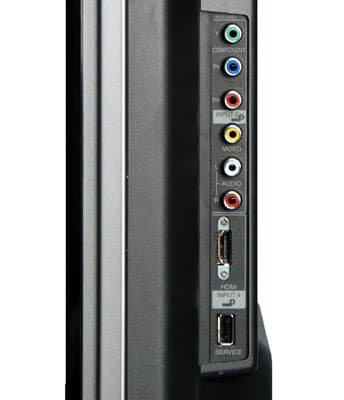

On the right side there are two nested sets of ports, which provide easy access to many of the connections.
On the closer set you will find another component video input, a composite video input, an analog audio input, an HDMI input and a USB port. On the one nested behind you will find two more HDMI ports, an analog audio input, a VGA input for a signla from a computer and a 3.5mm audio input so you can get audio from your computer as well.
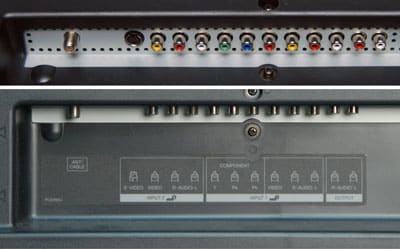
On the back you'll find a whole host of additional ports.
As with most TVs the output ports on the Sharp Aquos LC-46D64U are fairly limited. You have one analog audio output and a digital audio output. Both of these are meant to be used to connect your TV to a home stereo system. Unlike the Samsung LN46A650 there is no support for a 3.5mm headphone jack so you can plug headphones into the TV. There's also no way to get a video out from your TV.
The Sharp Aquos LC-46D64U doesn't offer any other connection types like Wi-Fi or Bluetooth.
The Sharp Aquos LC-46D64U does have a USB port, however this is only used for firmware upgrades and other service purposes. Unlike the Samsung LN46A650 you cannot plug a USB mass storage device with media on it into the port and then view the media on your television. As such we are not awarding points for the USB port. The Sharp Aquos LC-46D64U lacks any other form of media ports, including card readers.
The arrangement of the ports into three separate areas is a bit confusing at first, but it turns out to be well designed. Most of the ports that users will want to access quickly are found on the right side of the TV in the two nested areas. This makes them easy to reach and easy to see what you're doing. The ports found on the lower back of the TV are mostly supplemental, we recommend you use these to connect items that you won't need to manage very much. The labeling on the ports could be better, especially if there's not a lot of light when you're trying to figure things out the small font size will likely cause problems.
Controls & Menus
The Sharp Aquos LC-46D64U's menu system is displayed as a tabbed interface, as is typical, arranged along the top of the TV screen. You move left to right between the tabs starting with Picture then Audio, Power Control, Setup, Option and Digital Setup. As you activate a tab a menu will appear below it with the options for that section. You move up/down to navigate to those options. Many of them are sliders, which you can adjust using left/right while they are selected, a few open sub menus and others are simple on/off switches. The menu system isn't particularly pretty, but it is simple and straightforward. We did find the slight translucent effect a bit annoying, it makes it difficult to focus on the menu items if there is a fast paced scene on the TV, but otherwise we were happy with the interface.

A simple tabbed interface offers nothing too fancy or attractive.
Picture controls are the first item in the Sharp Aquos LC-46D64U's menu system. The main menu gives you access to a familiar selection of options including Backlight, Contrast, Brightness, Color, Tint and Sharpness. Each of these can be adjusted with a slider so fine increments are possible. In addition to these there is an option to look at Advanced picture controls. This opens one of the few sub-menus in the Sharp Aquos LC-46D64U's menu interface.
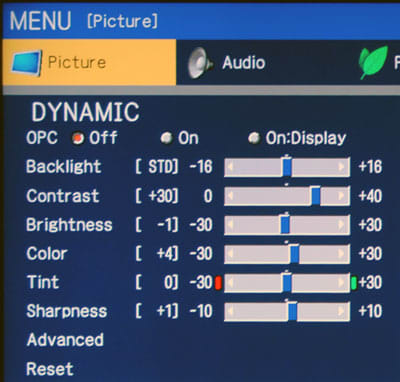
We like the array of options available in the Picture menu.
The Advanced controls offer their own tabbed interface with items listed on the left and settings for each item listed on the right. From top to bottom the picture options in the advanced menu are C.M.S.-Hue, C.M.S. Saturation, Color Temperature, Active Contrast, Fine Motion, I/P Setting, Film Mode, Monochrome and Range of OPC. Some of these offer an array of different sliders that can be adjusted, while others are simple on/off switches.

You have a lot of options in the advanced picture menu.
The Audio menu on the Sharp Aquos LC-46D64U is exceedingly simple. The top three options in the menu allow you to adjust Treble, bass and Balance. There is also an option to turn the simulated surround sound system on/off and another option to turn Bass Enhancer on/off. You can read more about what we think of the Sharp Aquos LC-46D64U's audio quality in the Audio section.
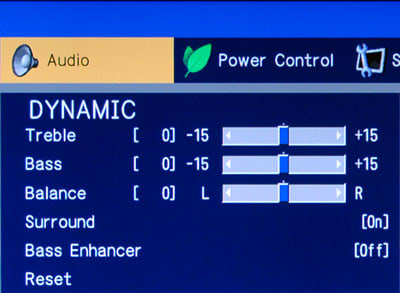
Audio controls are pretty vanilla.
In addition to Picture and Audio controls the Sharp Aquos LC-46D64U has several additional menus available to make adjustments. The Power Control menu offers two options to turn power saving options on/off. The Setup menu allows you to skip an input, change input labels, adjust screen position and language. You can also set parental controls using the V-Chip from this menu.

The parental controls only appear when you have something plugged into the RF port.
The Option menu offers options for Sharp's Aquos Link system, that allows you integrate your TV with other Sharp products. There's an option to play back Audio only, Digital Noise Reduction for particularly noisy video, HDMI Setup, Output Select and Game Play Time for those parents that want to control how long their kids sit in front of the TV blowing up monsters.
On the plus side the Sharp Aquos LC-46D64U's manual is pretty comprehensive and has good illustrations. On the negative side there's no table of contents, no index and the headers at the top of the page don't stand out much, so good luck finding what you want.
Formats & Media
The Sharp Aquos LC-46D64U supports all modern formats including 1080p, 1080i, 720p, 480p and 480i content. This means you shouldn't have any problems playing even the highest quality HD content on the TV. It als supports 3:2 pulldown and 24p, which are used to ensure that media formatted to look like film are rendered correctly. Finally, it supports the new xvYCC color space, which allows the TV to display a wider range of colors than those that lack this technology. This will really only come into play if you are watching media that supports the wider color gamut.
The Sharp Aquos LC-46D64U cannot play back photos.
The Sharp Aquos LC-46D64U cannot play back video files or music files.
The Sharp Aquos LC-46D64U does not support streaming video content from online sources like Youtube or Hulu.com.
The Sharp Aquos LC-46D64U does not include a DVR for recording television broadcasts.
Power Consumption

](https://www.reviewed.com/televisions/content/How-We-Test.htm#powerconsumption)
The Sharp LC46-D64U is not a power sipper, but it's not exactly a power guzzler either; we found that it used a pretty average amount of electricity for a HDTV of this size. In our tests, we found that this display would cost about 57 cents a week, or $29.94 to run for a year, assuming that you watched an average of 5 hours of TV a day, and that the display was calibrated to produce a peak luminance of about 200 cd/m2, the standard level we use in this test. We use this because it's a pretty good general setting for use in both daylight and a darkened room. We found that setting the backlight to -4 produced this light level.
The backlight setting makes a big difference on how much electricity LCD HDTVs use, and the LC46-D64U is no exception. It used an average of about 152 watts in our calibrated setting tests, but this fell to 95 watts when the backlight was at the minimum, which would take the cost down to $18.71. But if you take the brightness up the other way and crank it right up to +16 the display sucks down a bill-busting 275 watts, which would cost you $53.44 over a year. Although these figures are not bad for a display this size, they do underline how it makes sense to run the display at the minimum brightness level you need to save some energy.
Value & Comparisons
The Sharp Aquos LC-46D64U can be had for as little as $1300, a reasonable price for a television in its price range. In terms of value, however, we think you can do better. For example the Vizio VO47L is similarly priced and offers better performance and a more attractive finish. We recommend shopping around before purchasing the Sharp Aquos LC-46D64U.

Vizio VO47L - The Vizio is at a similar price point to the Sharp, but the Vizio has an edge in image quality. Neither TV is going to win any gold medals in the imaging olympics, but the Vizio is a better screen overall.

Panasonic TH-46PZ80U - This plasma screen is similarly priced to the Sharp, so the choice comes down to the pros and cons of the LCD vs plasma display types. The LCD-based Sharp is significantly brighter; put the two screens side by side and the Vizio is much more appealing to the eye. The Panasonic plasma does has better viewing angle and color accuracy, though, and those who assume that plasmas are expensive will be pleasantly surprised by the price.

Samsung LN46A750 - For a bit more cash, you get a lot more in terms of image quality and features. We'd strongly recommend considering the upgrade if the credit card will stand the strain.
Conclusion

The Sharp Aquos LC-46D64U is a television that makes a lot of concessions in order to achieve its reasonable price, and in our opinion makes too many. In particular it struggles producing an array of greys and accurate colors. Motion was also jerky and upscaling from lower resolution content was unimpressive. Although reasonably priced you can find HDTVs with better performance in the same price range, and you might want to check those competitors out.
Ratings & Specs
{{manufacturer_specs_table}}{{raw_scores_table}}
Meet the tester
Richard Baguley is a veteran writer who has written about technology ranging from Alphabet to Zip file utilities. He has contributed to pretty much every major tech publication, including Amiga Format Magazine, PC World, Wired, CNET, Toms Guide, Forbes, and many others. He lives in the Boston metro area with his wife, dog, and an indeterminate number of cats.
Checking our work.
Our team is here to help you buy the best stuff and love what you own. Our writers, editors, and experts obsess over the products we cover to make sure you're confident and satisfied. Have a different opinion about something we recommend? Email us and we'll compare notes.
Shoot us an email